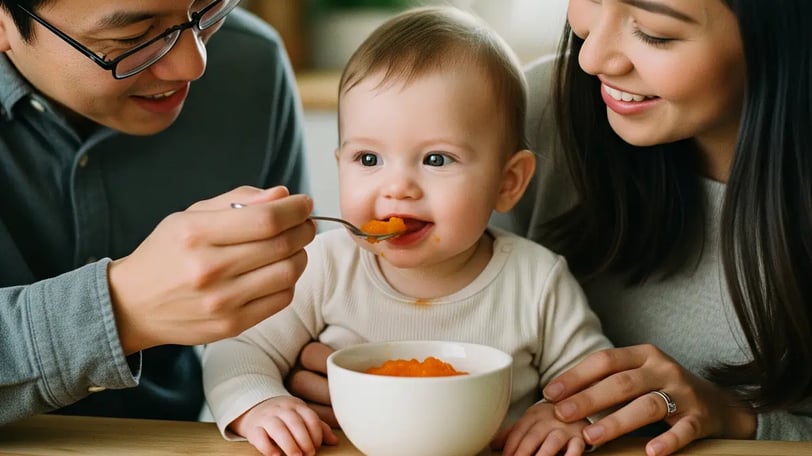Is Your Baby Ready for Solids? Here's What You Need to Know
Wondering when and how to start solids with your baby? Learn about readiness cues, first foods, and safety tips – plus how many cultures (Hindu, Bengali, Sikh, Nepali, etc.) celebrate this milestone with an Annaprashan-style ceremony. Friendly advice for new parents.
7/7/20256 min read


The first time your baby tries solids is a big milestone – and it’s often a cause for celebration! Pediatricians generally agree that around 6 months is the right time to introduce solid foods. In fact, babies get all their nutrition from breast milk or formula for the first six months, and health experts advise not introducing solids before about 4 months. Physically, a ready baby can sit with support, hold their head up, and open their mouth when offered food. Many parents watch for signs like watching you eat, reaching for your spoon, or moving purees to the back of the mouth (rather than automatically pushing food out). Another cue is weight – babies who have doubled their birth weight (often by 4–6 months) may be ready. However, every child develops at their own pace, so look for those developmental cues (head control, sitting, swallowing) rather than just counting months.
First Foods and Safety Tips
Once baby shows they’re ready, choose soft, easy-to-swallow foods. Pediatric guidelines suggest you don’t need to wait to introduce common allergens like eggs, peanuts, dairy or fish beyond 6 months – early exposure can help prevent allergies. Good first foods include pureed fruits (such as banana and applesauce), vegetables (like sweet potato and carrot), and iron-fortified cereals or pureed meats for extra iron.
Start simple: Begin with single-ingredient purees (one fruit or veggie at a time). Wait 3–5 days between new foods to check for any reactions.
Texture matters: In the beginning, feed your baby very smooth purees or mashed foods. You can mix cereals or grains with breast milk, formula or water to thin the texture and make it easier for the baby to swallow. As the baby becomes accustomed to solids, gradually offer thicker, lumpier textures to support their chewing development.
Safety first: Always watch your baby closely while eating. Avoid high-risk choking foods like whole grapes, nuts and seeds, raw vegetables, chunks of meat or cheese, popcorn, and sticky foods (like chunks of peanut butter). Cut finger foods into small pieces or strips, and never prop a bottle of cereal or formula – it can cause choking or overfeeding. Never give honey or cow’s milk as a drink before 12 months (honey risks botulism, and cow’s milk can overload baby’s kidneys). Focus instead on iron-rich foods (like pureed meats or iron-fortified cereal) since baby’s iron needs rise at this age.
Breastfeeding, Formula, and Solids
Remember that breast milk or formula remains baby’s main nutrition during this transition. Experts recommend exclusive breastfeeding (or formula feeding) for about 6 months. After introducing solids at six months, continue breastfeeding (or formula) for as long as you and your baby want – up to 2 years or beyond.
In practice, that means you’ll alternate between milk and solids. A helpful trick is to give baby a little breast milk or formula before feeding them solid food, then offer a very small spoonful of pureed food, and end with milk again. This sequence keeps baby from getting too frustrated with a new food texture.
It’s normal if your baby spits out or rejects a new food at first – they’ve never had anything thicker than milk! If baby fusses or turns away, don’t force it; pause and try again later. In the early days of feeding solids, baby will still be getting most of their nutrition from milk. Gradually, as they accept more solids, you’ll see them eating more at meal times. But until about one year old, breast milk or formula should still fill up their high-chair plate and their belly.
A Personal Story: Baby’s First Bite
I remember when my little girl, Maya, turned six months and it was time for solids. We’d been watching her cling to my hand while I ate, and one morning she excitedly grabbed a spoon during breakfast – I knew she was ready. We prepared some simple mashed sweet potato (no salt) and sat her up with a bib on. At first she wrinkled her nose at the unfamiliar taste, but after the second spoonful she grinned with delight. Of course, most of it ended up on her face and bib, but that messy moment felt like such a victory!
Because we come from a Punjabi Sikh family, we also had a tiny gurthi (first feeding) ritual. My mother whispered a short prayer and then held the kheer (sweet rice pudding) in a spoon marked with the emblem of the Khalsa. After the prayer, my husband spoon-fed Maya her first taste of kheer. The whole living room was smiling and clapping – it felt like welcoming her into our family’s traditions. Later that day, we shared the prasad (blessed pudding) with grandparents over tea.
Looking back, that day was special not just because of the milestone itself but because of how our family celebrated together. We still nurse Maya frequently, so milk is her comfort; solids are a supplement and a lot of fun. We take things slow – some days she barely eats and is full of breast milk, and other days she gobbles up banana mash or porridge. The key for us has been patience, lots of cuddles, and making sure she feels safe and loved with every new bite.
Celebrating the First Feeding: Annaprashan and Traditions




In many South Asian cultures, a baby’s first solid meal is honored with a festive ceremony. For example, the Annaprashan (literally “first rice”) ceremony is a traditional Hindu ritual marking this occasion. It often begins with prayers (puja) asking for health and blessings, followed by feeding the baby a sweet rice pudding (kheer) or grain-based porridge. The event is joyous and family-centered. In Hindu families from India or Nepal, close relatives take turns giving the baby spoonfuls of food while chanting blessings. Everyone shares small tastes, and the leftover blessed food (prasad) is distributed among the guests.
These ceremonies highlight symbolism as much as the solids themselves. Feeding the baby for the first time represents the child’s growth and the family’s hopes for their future. For instance, Nepali Annaprashan (also called Pasni) is often planned by a priest using the baby’s horoscope to pick an auspicious date (usually between 6 months and a year). On that day the baby is dressed in new clothes and fed by a beloved elder (often the maternal uncle or grandfather). Guests shower the child with gifts of clothes or jewelry, and the moment becomes one of shared pride and happiness.
Bengali Mukhe Bhaat (Rice in the Mouth):
In Bengali Hindu culture, the ceremony is called Mukhe Bhaat. The baby’s maternal uncle or grandfather traditionally feeds the first rice. Bengalis often hold Mukhe Bhaat at the mother’s home, and the baby wears a tiny golden mukut (headdress) or white topor hat. Sweet rice porridge (payesh) is customary, and as the uncle gives that first spoonful, relatives blow conch shells and the women ululate in celebration. It’s a lively, colorful event filled with love and pride.
Malayali Choroonu (Kerala):
In Kerala, the first feeding ceremony is called Choroonu. This usually happens around the 6th month, often in a temple. The baby is dressed in traditional attire and placed on an elder’s lap. After blessings, a banana-leaf plate with rice or kheer is offered, and the baby’s father or maternal uncle gives the first bite. A unique tradition is to dip a gold ring into the food and gently touch it to the baby’s lips – symbolizing health and prosperity.
Sikh Gurthi (First Feeding):
In Sikh tradition, there’s no mandatory ritual, but many families observe a simple gurthi (first taste) moment. The food may be touched with a Khanda for blessings, and followed by an Ardas (prayer). Modern Sikh families may hold a short prayer at home or Gurdwara, followed by a family meal where the baby is spoon-fed kheer or fruits.
Across these traditions, the first meal is more than just about nutrition – it’s symbolic. It represents new life, family unity, and hope for the child’s future. Even if you’re not holding a formal ceremony, you can still make your baby’s first solids special: cook a favorite pureed recipe, play gentle music, or take lots of photos.
Tips for New Parents
Go slow and steady: Start with just a teaspoon or two of food. Let your baby guide the pace. Some babies love solids immediately; others need days to warm up to the idea.
Keep milk in the mix: Breast milk or formula should still be offered at almost every meal at this stage. Think of solids as a side dish at first.
Make it nutrient-rich: Include iron and zinc at almost every meal (iron-fortified cereal, pureed meat, beans, or lentils).
Stay safe: Always supervise eating. Sit baby upright in a high chair. Cut finger foods into thin strips or small pieces. Mash or cook hard foods until soft.
Check with your doctor: Especially before introducing allergenic foods like peanuts or eggs.
Clean and comfortable environment: Wash your hands and baby’s hands before feeding. A small clean bib or cloth helps manage the mess. Let baby explore with fingers – that’s part of learning.
Final Thought
Enjoy the moment. The journey to solid foods is a big step for both baby and parents. Whether you’re quietly spooning in mashed peas at home or planning a festive Annaprashan ceremony with family, what matters most is meeting baby’s cues with love and care. These early meals often end up as cherished memories – the tiny messes, the giggles, and the shared smiles of family all make it worth celebrating.